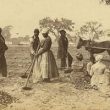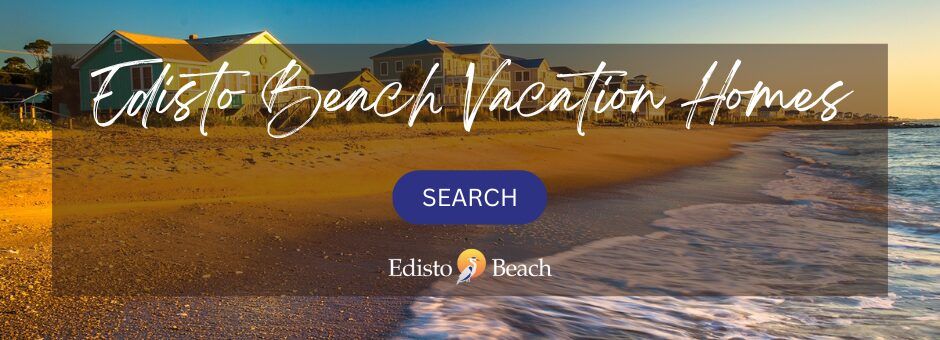Throughout the first half of the 19th century, Edingsville Beach was a popular destination for vacationers. It was located a few miles northeast between Jeremy Inlet and Botany Bay. It was initially established for wealthy Charleston families as a seasonal refuge to escape the humidity and heat in the Lowcountry. For a few decades, Edingsville Beach was the place for the elite to be seen.
In 1825, Edingsville Beach had about 60 tabby and brick houses that were mostly a two-story design with verandas facing the ocean. The homes were strategically placed in two rows and spaced far apart. One row overlooked the marsh while the other had a spectacular view of the ocean. This popular vacation destination also contained several churches, a billiard saloon, a schoolhouse, fishing shacks, service buildings, and boathouses.
An old newspaper clipping that was published in December 1955 described Edingsville Beach in its heyday. It provides a unique look back in time to reveal a quaint vacation area that encouraged vacationers to spend most of their nights dancing and listening to music while socializing with others. Soirees and dances were on most people’s daily itinerary.
This booming area was known for good times, but unfortunately, they weren’t meant to last. Visitors started to notice the shifting sands and ever-lapping tides took a toll on the beach. In addition, the Atlantic surf had managed to scoop up about 20 of the homes before the Civil War began.
During the Civil War, the island was uninhabited, and the erosion continued. An entry in a diary written by poet, educator, and abolitionist Charlotte Forten described what the island looked like during the war when she accompanied Union sailors to Edingsville Beach for a brief visit.
She described the summer resort being a favorite that attracted the aristocracy of Edisto. The beach was several miles long with once desirable dwellings that now featured a dismantled and desolate look. She noted gathering pretty tiny shells that were hiding deep in the sands.
By the time the Civil War was over, the only things left standing on Edingsville Beach were 40 houses, the billiard saloon, and two church buildings. Due to the devastation the war had on the plantation economy, most Lowcountry planters were bankrupt and abandoned their summer homes on the island forever.
Throughout the decade following the war, many of the beach houses were taken over by African American sharecroppers and farmers.
In 1885, Eberson Murray was present when the island took a direct hit by a hurricane. He was horrified to see the surge remove the porches from the homes on the island as he helplessly watched the horror when the high tide came. By nightfall, he reported the other oceanfront homes along with his had got swept into the Atlantic and disappeared for good.
After the storm, the only thing remaining was a couple of houses. The island was then completely abandoned, and by 1893, the Sea Island Hurricane erased the final structures from Edingsville Beach forever.
Today, memories and legends continue to be shared of this lost vacation resort. The only piece that still exists is a narrow strip of beach near the Jeremy Cay community that was once the marsh mentioned in the Edingsville Beach memories and stories. At low tide, residents and beachcombers enjoy searching for relics of the areas past at Jeremy Inlet.
In 2015, a Pennsylvania tourist visiting the north end of Edisto Island spotted a bone sticking out of the mud while the tide was coming in. He pulled out several bones before they had a chance to get washed away into the ocean.
Not long after that, a former ranger at Edisto Beach State Park, Ashby Gale, was on vacation and discovered a few teeth attached to a skull. The bones found in the mud and the cow skeleton were inspected by State Museum paleontologists were able to determine the bones date back to 1865 and 1870.
Dave and a team of volunteers decided to investigate further by taking a short walk along the beach. The team’s discoveries included chunks of tabby from the houses, wave-polished bricks, bits of rusted iron, glass, and broken pieces of historical ceramics.
As the team was about to finish up their research and investigation, they noticed a series of vertical rough-cut timbers interline with a layer of oyster shells that had been exposed recently due to the erosion of the overlying sands. The structure extends from the short dunes and leads into the surf.
While Edingsville Beach is now completely underwater and occasional artifacts are revealed, visitors and history buffs enjoy learning and hearing stories about the once-popular destination. In the past, the story of people seeing a lady in white walking on the deserted beach seeking the good old times in Edingsville Beach was both haunting and exciting. Who knows? Maybe when you visit, you might see the “Lady in White.”
Today, building standards in the area have improved dramatically and set in place to withstand hurricane-force winds. However, the shoreline movement remains a threat due to climate change and the rising sea level.
Communities located on the coast already notice and experience the effects of rising seas with sunny-day flooding and frequent intense storms. But, as the Atlantic slowly gobbles up Edisto Island history, you must visit unique places that have historical significance before they are swept away into the ocean.
Popular places to visit in Edisto Island include Botany Bay, The ACE Basin, bike paths, tunnel of trees, the Indian Mound, Driftwood Beach, Edisto Beach State Park, and more!
Also, when you visit, make sure you indulge in the culture of the Gullah people. They were West Africans enslaved to work the rice plantations on Edisto Island. Their unique way of preparing food and combining ingredients are the foundation of Southern cooking, and their recipes can be found in restaurants throughout the island.
You can also stand in the very place where they lived and worked when you visit Botany Bay and Edisto Beach State Park. Are you ready to explore Edisto Island history and enjoy some delicious Southern cuisine? Then, book your trip to Edisto Island today!







